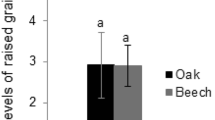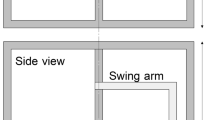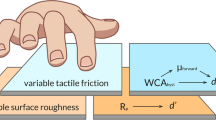Abstract
In wood machining operations, target surfaces are chosen to achieve technical functions (gluing, finishing), or aesthetic functions (raw wood, varnishing) in order to produce a surface which consumers will appreciate. Although the literature often refers to the optimization of cutting conditions to improve the surface quality, there is currently no specific criterion to define what good surface quality is. The purpose of this study was to investigate quantitative criteria related to consumer preferences and to find an acceptability threshold for each criterion in order to determine the best cutting conditions. To this end, 32 surfaces from Chrysophilum boivinianum (Sapotaceae) were machined in various cutting conditions which yielded surfaces ranging from very rough to smooth. The primary surface profile, roughness and waviness parameters, and machining defects (raised grain, torn grain, chip marks, cutting traces) were measured on each surface. Visual and visuo-tactile tests were then carried out with a panel of 174 consumers. The results show that touch allowed better appreciation of surface defects than a simple visual observation. Consumers like smooth surfaces without visible defects and less visible peaks of waviness. The acceptability thresholds of surface parameters correlated with consumer preferences were determined. The rotational speed and the feed speed affect the most the surface quality. To obtain good surface quality for consumers, the rotation speed should be greater than 5000 rpm, with a maximum feed rate per tooth of 0.5 mm, and a maximum average chip thickness of 0.18 mm. This knowledge will help industries to better optimize the cutting of wood.





Similar content being viewed by others
References
Aguilera A, Zamora R (2009) Surface roughness in sapwood and heartwood of Blackwood (Acacia melanoxylon R.Br.) machined in 90–0 direction. Eur J Wood Prod 67:297–301
ASTM-D1666-87 (1987) Standard test methods for conducting machining tests of wood and wood-based materials
Bumgardner M, Nicholls D, Donovan G (2007) Effects of species information and furniture price on consumer preferences for selected woods. Wood Fiber Sci 39:71–81
Cisia-Ceresta (1995) Aide-Mémoire statistique (Statistics aide-mémoire) (In French). Saint-Mandé, France
Coelho CL (2005) Influence of wood machining process on the objective characteristics and the subjective perception of finished surfaces. PhD Thesis, Faculty of engineering at University of Porto, Portugal
Coelho CL, Carvalho LMH, Martins JM, Costa CAV, Masson D, Meaussone J-P (2008) Method for evaluating the influence of wood machining conditions on the subjective characterization and subjective perception of a finished surface. Wood Sci Technol 42:181–195. doi:10.1007/s00226-007-0166-1
Cool J, Hernández RE (2012) Effects of peripheral planing on surface characteristics and adhesion of a waterborne acrylic coating to black spruce wood. Forest Prod Soc 62(2):124–133. doi:10.13073/0015-7473-62.2.124
Costes JF (2001) Approche de l’usinage à grande vitesse du bois: application au défonçage. (An approach to high-speed machining of wood: application in router (In French). PhD thesis, Université de Toulouse III
Eyma F (2002) Caractérisation des efforts de coupe de différentes essences de bois à l’aide de leurs paramètres mécaniques (Cutting forces characterization of different wood species using their mechanical properties) (In French), PhD thesis, Université Henri Poincaré, Nancy 1, France
Farrokhpayam SR, Ratnasingam J, Nazerian M, Bakar ES, Hong TS (2011) The effect of machine parameters on the surface quality in planing of rubberwood. J Basic Appl Sci Res 1(11):2329–2335
Fujiwara Y, Fujii Y, Sawada Y, Okumura S (2001) Development of a parameter to reflect the roughness of a wood surface that corresponds to tactile roughness: a novel filter to exclude local valley effects. Holz Roh Werkst 59:351–355
Fujiwara Y, Fujii Y, Sawada Y, Okumura S (2004) Assessment of wood surface roughness: comparison of tactile roughness and three-dimensional parameters derived using a robust Gaussian regression filter. Wood Sci 50:35–40
Fujiwara Y, Fujii Y, Okumura S (2005) Relationship between roughness parameters based on material ratio curve and tactile roughness for sanded surfaces of two hardwoods. Japan Wood Res Soc 51:274–277
Goli G (2003) Surfaces de bois obtenues par défonçage: étude de la mécanique de formation et des défauts induits. (Wood surfaces machined with router: study of the surface creation mechanisms and the induced defects) (in French). PhD thesis, Ecole Nationale Superieure d’Arts et Metiers (ENSAM), Cluny, France
Goli G, Negri M, Marchal R, Larricq P (1997) The machining process of the European Douglas fir: the surface quality. In: proceedings of the 3rd International Conference on the Development of Forestry and Wood Science/Technology (ICFWST), Serbia, Yougoslavia, pp 473–480
Goli G, Larricq P, Marchal R, Negri M, Costes JP (2001) Surface Quality: Comparison among visual grading and 3D roughness measurements. In: proceedings of the 15th International Wood Machining Seminar (IWMS), Los Angeles, California, USA, pp 459–472
Guest S, Spence C (2003) What role does multisensory integration play in visuotactile. Int J Psychophysiol 50:63–80
Hanbury A, Gardieu F (2001) A quantitative description of wood texture. In: proceedings of the International Conference on Quality Control by Artificial Vision (QCAV), Bourgogne, France, pp. 200–205
Hoibo O, Nyrud AQ (2010) Consumer perception of wood surfaces: the relationship between stated preferences and visual homogeneity. J Wood Sci 56:276–283
ISO 25178-2 (2012) Geometrical product specification (GPS)–surface texture: Areal–Part 2: Terms, definitions and surface texture parameters
ISO/DIS 11136 (2013) Sensory analysis—methodology—general guidance for conducting hedonic tests with consumers in a controlled area
Jodin P (1994) Wood the engineering material. ENGREF, Nancy, France
Juan J (2007) Travail mécanique du bois–Lois générales de l’usinage (Wood machining operation–General rules) (In French). Edition T.I, France
Khazaeian A (2006) Caractérisation 3D de l’état de surface du bois: stratégie de mesure–influence des paramètres lies à l’essence et à l’usinage (3D wood surfaces characterization: measurement strategy–influences of species and machining parameters) (In French). PhD thesis, IUT GMP de Tarbes, Equipe Productique Bois–Université Paul Sabatier. Toulouse III. France
Kilic M, Hiziroglu S, Burdurlu E (2006) Effect of machining on surface roughness of wood. Build Environ 41:1074–1078
Kortchagina I, Ovtchavora L, Prokofieva L, Festy P, Verger D (2005) Conditions de vie et pauvreté en Russie (The living conditions and poverty in Russia) (In French). Economie et statistique n° 383–384–385, pp 1–26
Kuljich S, Cool J, Hernández RE (2013) Evaluation of two surfacing methods on black spruce wood in relation to gluing performance. Japan Wood Res Soc 59:185–194
Lundberg IAS, Porankiewicz B (1995) Studies of non-contact methods for roughness measurements on wood surfaces. Holz Roh Werkst 53:309–324
Manuel A, Leonhart R, Broman O, Becker G (2015) Consumers’s perceptions and preference profiles for wood surfaces tested with pairwise comparison in Germany. Ann For Sci 72:741–751
Mothe F (1985) Essai et comparaison de trois méthodes de classement de surface de bois massif pour leur rugosité: méthodes pneumatiques et sensorielles (Experimentation and comparison of three classification methods of solid wood depending on their roughness: pneumatic and sensorial methods) (In French) Ann For Sci pp 435–452
Rajemison HA (2013) Proposition d’essences de substitution aux bois précieux en épuisement par la connaissance des propriétés du matériau bois: cas du Palissandre de Madagascar–application en ameublement (Research of wood species to substitute threaten precious ones from the knowledge of their properties: case of the Madagascar’s pallisander for furniture application) (In French). PhD thesis, ESSA/Eaux et Forêts, Université d’Antananarivo, Madagascar and Université de Toulouse III, France
Raju BI, Srinivasan MA (1999) Encoding and decoding of shape in tactile sensing. Technical report 630. The Research Laboratory of Electronics at the Massachusetts. Institute of Technology, Cambridge, Massachusetts
Rakotovao G, Rabevohitra ARP, Guibal D, Gerard J (2012) Atlas des bois de Madagascar (Atlas of Wood from Madagascar) (In French). Editions Quae, France, pp 113–114
Ramananantoandro T (2005) Implications tactiles et visuelles de la rugosité du bois et des matériaux dérivés du pin maritime (Visual and tactile implications of roughness of maritime pine wood and wood-based panels) (In French), PhD Thesis, Ecole Nationale Supérieure des Mines de Saint-Etienne et Université Jean Monnet de Saint–Etienne, France
Ramananantoandro T, Ramanakoto MF, Rajemison AH, Eyma F (2013) Relationship between density and aesthetic attributes of wood and preference of Malagasy consumers. Ann For Sci 70:649–658
Ramananantoandro T, Larricq P, Eterradossi O (2014) Relationships between 3D roughness parameters and visuotactile perception of surfaces of maritime pinewood and MDF. Holzforschung 68(1):93–101
Roorda A, Williams DR (1999) The arrangement of the three cone classes in the living human eye. Nature 397:520–522. doi:10.1038/17383
Sande JB, Nyrud AQ (2008) Consumer preferences for wood surfaces—a latent variable approach. Proceedings of the Biennial Meeting of the Scandinavian Society of Forest Economics, vol 42 edn., pp 195–215
Sinn G, Gindl M, Reiterer A, Stanzl-Tschegg S (2004) Changes in the surface properties of wood due to sanding. Holzforschung 58:246–251. doi:10.1515/HF.2004.038
Sinn G, Sandak J, Ramananantoandro T (2009) Properties of wood surfaces—characterisation and measurement: a review. Holzforschung 63:196–203
Twaddle A (1997) The influence of species, chip length, and ring orientation on chip thickness. Tappi J 80(6):123–131
Weinfurter S, Eder A (2009) Consumer perceptions of innovative wood-polymer composite decking with a focus on environmental aspects. Lenzinger Ber 87:168–178
Acknowledgments
We owe special thanks to: the International Foundation for Science for funding the project; the French Embassy in Madagascar for granting a scholarship to perform wood machining in France and all persons who participated in the sensory analysis. The authors wish to thank MESA industry in Anosy Avaratra, Antananarivo, for providing the wood samples used in the study, and Dr. Vonimihaingo Ramaroson, head of the sensory analysis laboratory (LAS) in Ambatobe, Antananarivo.
Author information
Authors and Affiliations
Corresponding author
Rights and permissions
About this article
Cite this article
Ramanakoto, M.F., Andrianantenaina, A.N., Ramananantoandro, T. et al. Visual and visuo-tactile preferences of Malagasy consumers for machined wood surfaces for furniture: acceptability thresholds for surface parameters. Eur. J. Wood Prod. 75, 825–837 (2017). https://doi.org/10.1007/s00107-016-1098-y
Received:
Published:
Issue Date:
DOI: https://doi.org/10.1007/s00107-016-1098-y




